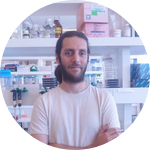About This Project
We're studying how yeasts make decisions about their cellular fate during mating, a process that involves the integration of information with opposing effects.
To study how cells choose between mating and asexual reproduction, we observe and track single cells using automated time-course microscopy, over many different conditions.
To gain a deeper understanding of this process, we need a massive amount of data, and new open hardware tools, that also enable any lab to make these discoveries.
Ask the Scientists
Join The DiscussionWhat is the context of this research?
Our experiment requires observing several yeast strains over many conditions, which scales rapidly to dozens or hundreds of combinations.
Even though robots for automated high-throughput experiments have been built for experiments, but are closed source and prohibitively expensive.
Our open hardware pipetting robot already automates the preparations, but only prepare one condition at a time. This means that it still takes too long, and we often miss the decision making event, sometimes by hours.
Recently Edwin's nano-positioner project provided the ultimate solution. We can reuse the miniature piezoelectric devices to power 96-channel pipettes, and enable high-throughput experimentation on all pipetting robots.
What is the significance of this project?
Understanding cell biology is the key for next generation medicine and biotechnology. It is, however, a very complex system, and it is also hard to observe quantitatively. To face this challenge we need better and also affordable tools, enabling the average molecular biology lab to acquire them.
A 96-channel micropipette will make preparations a hundred times faster, which will let us catch every detail of the decision making process, and provide the data we need to understand it.
This project will conclude with the publication of open assembly documentation and design files for our tool. In this way, labs all over the world will be able to acquire or build it for a small fraction of the cost of proprietary devices.
What are the goals of the project?
Our first objective is to build a 96-channel micropipette with independently controlled channels, expanding the frontier of automation to reach science labs
everywhere.
We will then use the tool to prepare a 384-well microscopy plate with 16 yeast strains, over 48 experimental conditions. This will reduce the preparation time from hours to minutes, letting us observe the phenomena during its timescale, in high resolution.
The images will then be processed to identify single cells in the microscopy images, track them over time, and derive quantitative data (signal intensity, distribution, cell morphology, and cell-cycle events). Automated inference techniques will process the vast data, and extract causal new relationships explaining more of the cell's biology.
Budget
With this budget we will purchase the minimum amount of parts required to build an SBS-compliant pipetting tool-head with 96 independently-driven channels.
All molecular biology consumables and equipment are already available, funded by national science agencies. A technician will be hired to prototype and manufacture the custom parts.
Endorsed by
 Project Timeline
Project Timeline
We will work on a total of four development milestones, each 8-weeks long, starting as soon as parts arrive :)
Jul 02, 2023
Project Launched
Sep 30, 2023
Working principles: replace the actuation mechanism in our current pipettes with a piezo-based actuator, and characterise it.
Oct 31, 2023
96-channel design: multiplex the controller electronics, design the shaft array, and tip ejection plate.
Nov 30, 2023
Assembly and documentation: fabricate parts for the multiplex design and document the assembly process.
Dec 30, 2023
Put it to the test: use the 96-channel head to prepare humanly impossible stimuli combinations in a 384-well microscopy plate.
Meet the Team
Team Bio
This team was formed 3 years ago through reGOSH, a network fostering free tech for science and education in Latin America, stemming from the Gathering for Open Science Hardware (GOSH), its global counterpart.
Nicolás became involved in the development of open science hardware (OScH) for automation during his PhD studies, about on the molecular biology of yeast.
Gastón co-founded TECSCI, an open hardware startup, and is a professor at the National University of San Martín.
Nicolás Méndez
Biotechnologist and tinkerer by nature. I have specialized in the automation of molecular biology, with a strong focus on developing the base open-source technology and lowering entry barriers to automated experimentation.
I lead the OLA project, and have enjoyed making and integrating open and affordable equipment for biology labs, helping others do more with their time.
Additional Information
Additional electronics expertise and manufacturing capabilities will be provided by TECSCI, a local OScH startup, incubated at the National University of San Martín.
The full development process will be open, just as our pipetting bot.
Project Backers
- 7Backers
- 101%Funded
- $7,178Total Donations
- $1,025.43Average Donation

